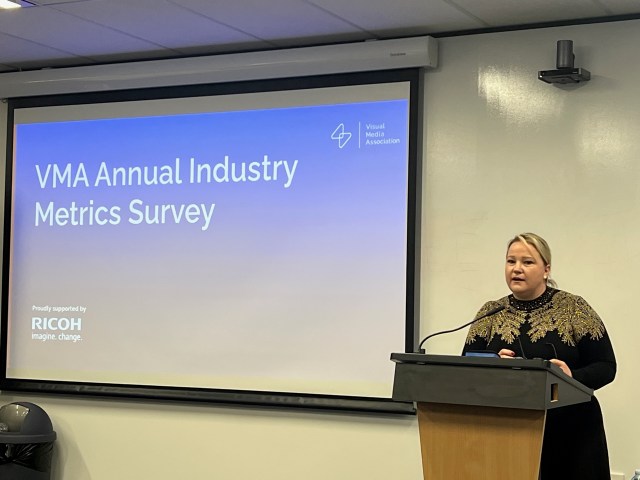
The Visual Media Association has released findings from its 2024 Annual Industry Metrics Survey.
The Annual Industry Metrics Report, supported by Ricoh Australia, captures salary benchmarks, skills and training levels and shortages, employment demographics, customer group breakdowns, certifications, operational practices, perceived challenges and more.
Produced with members and key industry stakeholders, the primary aim of the survey is to provide members and industry, investors, government and key stakeholders valuable insights into the state of the industry to support informed decisions, establish business benchmarks to best practice, and identify trends.
The VMA is currently hosting a roadshow across the country to present the findings. The roadshow kicked off with events in Melbourne and Adelaide this week. More events will follow in Perth, Sydney, and Brisbane over the next week.
“We need this data for our industry,” VMA CEO Kellie Northwood told attendees in Adelaide yesterday.
“This data helps business owners with their planning and forecasting. If you’re considering new investments – what should I be investing in? What are others investing in? Where am I sitting when you look at financial benchmarks? Where am I sitting with salary benchmarking? These are things that really help your businesses, and the more data we get the more we can build in on it.”

According to the VMA report, industry employment figures represented stability across most sectors since last year’s Annual Industry Metrics report. In 2024, total industry employment is 229,113, a modest decrease from last year’s 229,194.
“This is an incredibly strong number. We still sit as one of the largest manufacturing employees in the country,” Northwood said.
“What’s also interesting is that despite recent consolidation of our industry, we are increasing in the number of businesses recorded under the ABS as ‘print of visual media related services’ businesses, with a rise from 4414 businesses recorded in 2023 to 4435 in 2024.
“We remain a male dominated industry, but that number is coming down. It was 64 per cent in 2023, as compared to 58 per cent in 2024. We have more women joining the industry, which is terrific, and what we’re also seeing, which I am really excited by, is that our industry is one of the fastest growing for female apprentices.”

A notable finding in the survey was the increased number of apprentices in the industry, with 77.78 per cent of businesses currently employing one or more first year/stage 1 appreciates, compared to 38.46 per cent in 2023. More than 75 per cent of businesses currently employ one or more second year/stage 2 apprentices, compared to 53.85 per cent in 2023.
“In 2023, our apprenticeship numbers were quite low, but we’ve since seen this surge,” Northwood said.
“What we’re also seeing is that we’re attracting talent from different cohorts. One industry that is struggling [for employment] in Australia is graphic design. One of the largest cohorts of apprentices coming into pre-press and print are now coming from the design channel. There just aren’t enough jobs to designers in this country.

“A lot of design is being offshored, and we have great, talented people who have an eye for creativity and understanding of the software. So, if you’re looking for apprentices and not sure where you can attract them, have a think about your local design college.”
An emerging trend noted in the report is cyber security, with 76 per cent of Australian businesses reporting they are struggling with their development of cyber security readiness.
“As an industry, we must start building cyber security and data management systems. I know some of you will have some policies and procedures in place, but this is not a ‘set and forget’, and we need to make sure that our industry is building best practice cyber security and updating best practice each year,” Northwood said.
Some of the key findings contained in the 2024 VMA Annual Industry Metrics Survey:
General industry trends
- Total industry employment is 229,113, reflecting the largest sovereign manufacturing employer in the country
- 4,435 (4,114 in 2023) businesses are registered as print or visual media businesses across Australia, with most businesses being in New South Wales (28.75 per cent) and Victoria (28.75 per cent)
- 67.50 per cent of businesses operate across a single site
- 86.25 per cent of companies are privately owned and operated
- More than a third of industry businesses reported $500,000 and $3.5 million in annual turnover
- Only 17.5 per cent of businesses reported less than $1 million in turnover
- 37.5 per cent of businesses report $1 million to $5 million in annual turnover
- 37. 5 per cent of businesses report $5 million to $50million in annual turnover
- 17.5 per cent of businesses report less than $1 million in annual turnover
- 7.5 per cent of businesses report $50 million to $100 million in annual turnover
- 57 per cent of businesses say labour is the highest cost to their business
Quoting jobs and workflow
- Email ordering (59.95 per cent) is the predominant avenue in which job orders are received. Direct sales orders are also common (27.09 per cent), followed by external EDI or API connection (15.33 per cent) and e-commerce/web to print (14.82 per cent)
- 34 per cent of businesses report average job size has increased; however, 19.74 per cent report job size declined significantly
- 62.5 per cent of volume trends are linked to seasonal campaigns, such as Easter, Christmas, or sporting events
- 41.07 per cent of volume trends are linked to education and government, such as elections, budgets, or school terms
- Four in 10 businesses are collecting payment owing within 30 days
Service offering and diversity
- 84 per cent of average job size are under 1000 units, with 30.6 per cent being under 500 report offering commercial print – digital to market
- 42 per cent of businesses are looking to invest in new equipment and upgrades to expand service offerings
- Diversification investment is reported to occur mostly in the next one to two years with 43.09 per cent reporting this focus
- Packaging, warehouse, and logistics and finishing are the three top growth areas (this is the second year that packaging ranks the highest in diversification investment)
- In 2023, promotional products and merchandise and wide format fell into the top three, 2024 reports these sectors are receiving investment, however, warehouse and finishing is pushing ahead
Employment, skills, and training
- 83.52 per cent of employees are full-time (80.11 per cent in 2023)
- 16.14 per cent of employees are part-time (16.34 per cent in 2023)
- 7.21 per cent of employees are casual employees (12.94 per cent in 2023)
- 4.07 per cent are contracted employees (4.37 per cent in 2023)
- 38.75 per cent of companies currently employ less than 10 employees
- 26.25 per cent of companies currently employ 11 to 30 people
- 12.5 per cent of companies currently employ 51 to 100 people
- 64.91 per cent of industry employ men, while 38.63 of industry employ women and 8.33 per cent employ non-binary people
- Finding candidates with the right skills in the biggest challenge for the industry (68 per cent) and a further 47.3 per cent report finding job-ready candidates is challenging
Labour and salary benchmarking
- 77.78 per cent currently employ one or more first year/stage one apprentice (38.46 in 2023)
- 77.78 per cent currently employ one or more second year/second stage apprentice (53.85 per cent in 2023)
- 55.56 per cent currently employ one or more third year/third stage apprentice (30.77 per cent in 2023)
- 33.33 currently employ one or more fourth year/fourth stage apprentice 30.77 per cent in 2023)
- 2.44 per cent of companies pay 100 per cent to the award (10.29 per cent in 2023)
- 26.83 per cent of companies pay five to 10 per cent above the award (38.24 per cent in 2023)
- 39.02 per cent of companies pay 11 to 20 per cent above the award (36.76 per cent in 2023)
- 21.95 per cent of companies pay more than 20 per cent above the award (5.88 per cent in 2023)
Business certifications and standards
- 51.35 per cent of businesses hold no certifications
- 27.03 per cent of businesses are ISO9001 certified
- 24.32 per cent of businesses are FSC certified
- 8.11 per cent of businesses report carbon mapping
- 8.11 per cent of businesses are SGP certified
- 16.22 per cent of businesses have other certifications
- 18.92 per cent of businesses are ISO 14001 certified
- 8.11 per cent of businesses are PEFC certified
- 8.11 per cent of businesses are APCO certified
Comment below to have your say on this story.
If you have a news story or tip-off, get in touch at editorial@sprinter.com.au.
Sign up to the Sprinter newsletter




